-
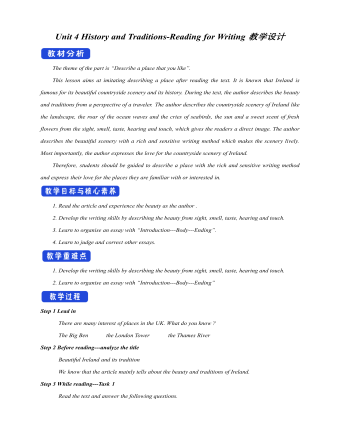
新人教版高中英语必修2Unit 4 History and Traditions-Reading for Writing教案
Step 1 Lead inThere are many interest of places in the UK. What do you know ?The Big Ben the London Tower the Thames RiverStep 2 Before reading---analyze the titleBeautiful Ireland and its traditionWe know that the article mainly tells about the beauty and traditions of Ireland. Step 3 While reading---Task 1Read the text and answer the following questions.Q1: What makes the Irish countryside exciting and inspiring?Its beauty and how it offers something for all the scenes.Q2: What are the best ways to experience some Irish traditions and cultures?By stopping by a village pub and relaxing with a drink and traditional meal while listening to music and watching dancingQ3: What is the meaning of “breathe in the sweet scent of fresh flowers while birds greet the new day with their morning song ?”It means to not just smell but also breathe in the smell of fresh flowers early in the morning as the birds sing their first song of the new day.Q4: What are the best ways to experience Chinese traditions and customs ?By travelling to different places and using all your senses to experience everything and by interacting with local people.Step 4 While reading---Task 2Analyze the descriptive paragraph1. Identify and underline the paragraph’s introductory sentence and the ending sentence.Introductory sentence: Ireland’s beautiful countryside has always had a great influence on its people and traditions.Ending sentence: And if you introduce yourself to a friendly face, you are more than likely to experience local culture and customs first-hand.2. The paragraph talks about different senses in different places. Write the senses and places in the order that they appear.
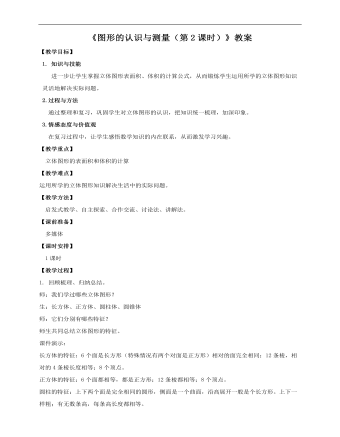
小学数学人教版六年级下册《第五课图形的认识与测量(第2课时)》教案说课稿
【课时安排】 1课时【教学过程】1.回顾梳理、归纳总结。师:我们学过哪些立体图形?生:长方体、正方体、圆柱体、圆锥体师:它们分别有哪些特征?师生共同总结立体图形的特征。 课件演示:长方体的特征:6个面是长方形(特殊情况有两个对面是正方形)相对的面完全相同;12条棱,相对的4条棱长度相等;8个顶点。正方体的特征:6个面都相等,都是正方形;12条棱都相等;8个顶点。圆柱的特征:上下两个面是完全相同的圆形,侧面是一个曲面,沿高展开一般是个长方形。上下一样粗;有无数条高,每条高长度都相等。
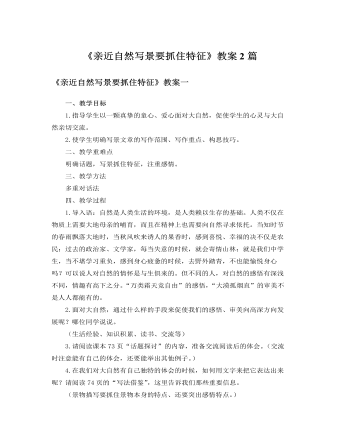
人教版高中语文必修2《亲近自然写景要抓住特征》教案2篇
一、教学目标1.指导学生以一颗真挚的童心、爱心面对大自然,促使学生的心灵与大自然亲切交流。2.使学生明确写景文章的写作范围、写作重点、构思技巧。二、教学重难点明确话题,写景抓住特征,注重感情。三、教学方法多重对话法四、教学过程1.导入语:自然是人类生活的环境,是人类赖以生存的基础。人类不仅在物质上需要大地母亲的哺育,而且在精神上也需要向自然寻求依托。当知时节的春雨飘落大地时,当秋风吹来诱人的果香时,感到喜悦、幸福的决不仅是农民;过去的政治家、文学家,每当失意的时候,就会寄情山林;就是我们中学生,当不堪学习重负,感到身心疲惫的时候,去野外踏青,不也能愉悦身心吗?可以说人对自然的情怀是与生俱来的。但不同的人,对自然的感悟有深浅不同,情趣有高下之分。“万类霜天竞自由”的感悟,“大漠孤烟直”的审美不是人人都能有的。2.面对大自然,通过什么样的手段来促使我们的感悟、审美向高深方向发展呢?哪位同学说说。
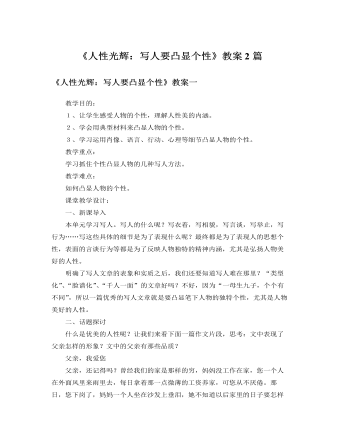
人教版高中语文必修1《人性光辉:写人要凸显个性》教案2篇
(学生展开畅叙所谈,言之有理即可。)归纳:以上因素在人物语言表达中是综合体现的,所以在写作时必须周密思考,使人物语言体现的人物性格更丰富,更有立体感。(3)行动描写矛盾先生曾说:“人物性格必须通过行动来表现。”我们在写作文时,应当注意描写最能揭示人物本身的独特性格的,最合乎人物地位,身份的动作,从而使人物形象更生动。行动描写要注意哪些方面?A、选择具有代表性,最能表现人物性格的行动来写。如《守财奴》中的老葛朗台的性格特点。B、要善于选择具有表现力的动词,把人物的行动准确传神地描写出来。(4)侧面描写写作不仅可以从正面对人物加以刻画,也可以通过周围各种不同人物的眼看,嘴讲等方式,从侧面起到烘托某个特定人物的作用。(请学生欣赏片段《茶花女》,《红楼梦》,教师归纳。)
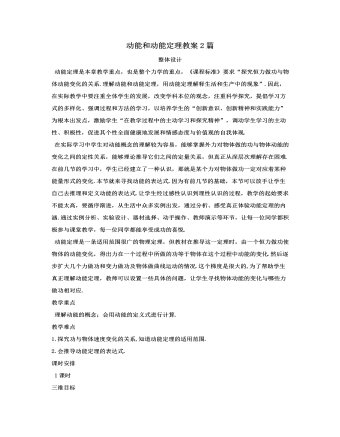
人教版新课标高中物理必修2动能和动能定理教案2篇
二、课堂教学(课前由科代表发回预习学案)1、教师根据预习学案检查结果提出问题(用多媒体展示),引导全班讨论(重点讨论:①、为什么动能的表达式一定是 mV2 ?你如何得出这个结论?②、力在一个过程中对物体所做的功,和物体在这个过程中动能的变化量有什么关系?你如何得出这个结论?这个做功的力和F=ma中的力F有什么关系)。有困难的小组应及时问老师。老师在这个过程中巡视指导。2、学生自主阅读课文“7 动能和动能定理”中的“动能的表达式”,然后完成如下练习(教师在此过程中巡视指导):2.1尝试推出动能的表达式(鼓励会推导的同学积极上台板演,老师引导讨论)。2.2写出动能的小结(认真阅读教材p66倒数第二段、第三段,结合你推导动能表达式的过程,认真思考后四人一组讨论:①、动能是矢量还是标量?②、动能的单位是什么?③、你认为应从哪几方面来理解动能?)
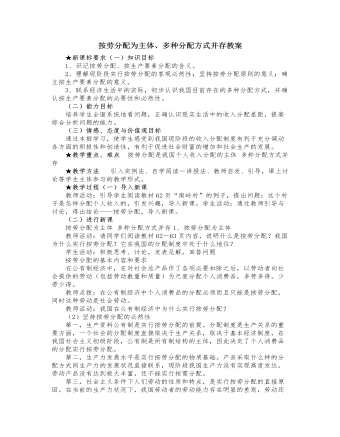
人教版高中政治必修1按劳分配为主体、多种分配方式并存教案
(3)确立按生产要素分配的意义确立按生产要素分配的原则,是对市场经济条件下各种生产要素所有权存在的合理性、合法性的确认,体现了国家对公民权利的尊重,对劳动、知识、人才、创造的尊重。有利于让一切生产要素的活力竞相迸发,让一切创造社会财富的源泉充分涌流,以造福人民。(三)课堂总结、点评 通过这节课的学习,我们懂得了在我国社会主义初级阶段,实行以按劳分配为主体、多种分配方式并存的制度,把按劳分配和按生产要素分配结合起来具有客观必然性,也有重要的意义。★课余作业 组织学生撰写社会调查报告,要求学生调查自己家里的收入情况,分清哪些收入是按劳分配所得,哪些是非按劳分配收入,并进一步分析现在的收入形式与以前相比有哪些变化,这种变化给家庭的生活带来哪些影响?★教学体会本节内容是与学生生活实际密切联系的内容,在学习中应该多引入日常生产、生活中常见的一些实例,让学生去深刻理解这些知识,并能够从自己的实践中理解、把握我国分配政策的合理性。
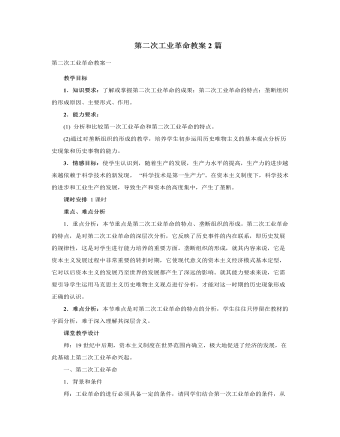
人教版高中历史必修2第二次工业革命教案2篇
请回答:根据上述材料,概述第二次工业革命兴起的主要原因。〖参考答案〗①政治上,资本主义制度在世界范围内的确立,为第二次工业革命提供了政权保障。②市场上,世界市场进一步拓展,推动生产进步发展。③科技上,19世纪自然科学的飞速发展与重大突破。④劳动力上,拥有更多、素质更好的自由劳动力。⑤经济上,拥有更加雄厚的资本。探索攻关二:第二次工业革命与垄断组织的出现的关系材料一第二次工业革命产生的新兴工业部门,在厂房、设备、技术要求和产品结构的复杂性等方面,都对生产组织提出了新的要求。这是过去的独家企业无法满足的,而且一般没有足够的资金。……于是,集中资金的合股公司迅速增加起来,起大型企业垄断组织也就应运而生。

人教版高中政治必修4第十课创新意识与社会进步教案
2.辩证的否定(1)辩证的否定是事物的自我否定。事物内部存在着肯定方面和否定方面,它们既对立又统一。最初,肯定方面处于支配地位,否定方面处于被支配地位。在这种情况下,事物就被肯定着。但是,在矛盾双方的斗争中,否定方面总会由弱变强。一旦否定方面由被支配地位上升为支配地位,事物就转化到了自己的对立面,实现了对事物的否定。事物最终之所以被否定,根源在于事物的内部,是事物内部的否定因素战胜了肯定因素。因此,事物的否定是自我否定。(2)辩证的否定是事物发展的环节和联系的环节。所谓发展,是指新事物的产生和旧事物的灭亡。而实现这一过程必须要对旧事物进行否定,否定实现了事物由旧质向新质的飞跃。新事物在否定旧事物时,并不是把旧事物全盘抛弃,一笔勾销。旧事物是新事物的母体,新事物从旧事物那里脱胎而来,新事物是在批判地继承旧事物中的一切积极的有生命力的因素的基础上发展起来的。这样,在新旧事物之间就存在着必然的联系。
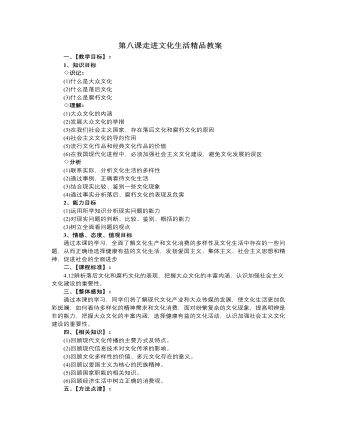
人教版高中政治必修3第八课走进文化生活精品教案
1.加强社会主义文化建设的必要性在人类历史的长河中,各种思想文化总是相互冲击、交汇、融合.奔腾向前,永不停息。今天,我们面对的文化有传统的和现代的、外来的和本土的、进步的和落后的、先进的和腐朽的、积极的和颓废的,等等。各种各样的文化有吸纳又有排斥,有融合又有斗争,有渗透又有抵御,呈现出前所未有的相互交织、相互激荡之势。在这种文化发展的大背景下,在我国现代化建设过程中,有必要弘扬我国社会主义的主流文化,这样有利于保证我国社会主义文化发展的方向。2.大力加强社会主义文化建设(1)中国特色社会主义文化在我国文化生活中处于主导地位。中国特色社会主义文化,始终坚持以科学的理论武装人,以正确的舆论引导人,以高尚的精神塑造人,以优秀的作品鼓舞人,无论是思想内容还是表现形式,都发挥着强有力的导向和示范作用。社会主义文化以其自身的科学性和先进性,并依靠社会主义政治和经济力量,在人民大众的文化生活中始终占据着主导地位。
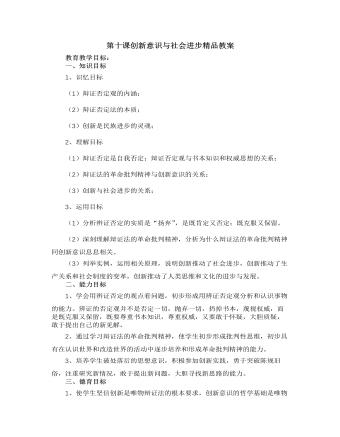
人教版高中政治必修4第十课创新意识与社会进步精品教案
在数学上,0这个数是解决记数和进位问题而引进的概念,由于它不能表示实在的东西,很长时间人们不把它看作是一个数。认为0是无,是对有的否定。从唯物辩证法的观点看,这种否定不是形而上学的简单否定,而是具有丰富内容的辨证否定。辨证的否定是发展的环节。0是从无到有的必经之路,是连接无和有的桥梁。0又是正数和负数之间的界限,它既否定了任何正数,也否定了任何负数,是唯一的中性数。但它又是联结正数和负数的中间环节。没有0,负数就过渡不到正数去,正数也休想发展到负数来。数学中的0是对任何定量的否定。如果没有这一否定,任何量的发展都无从谈起。这个否定不是一笔勾销,而是扬弃。因为它克服了任何定量的有限性,成为其发展的环节。在现实生活中,0作为辨证的否定,也体现出联系和发展的性质。如0度不是没有温度,而是非常确定的温度。
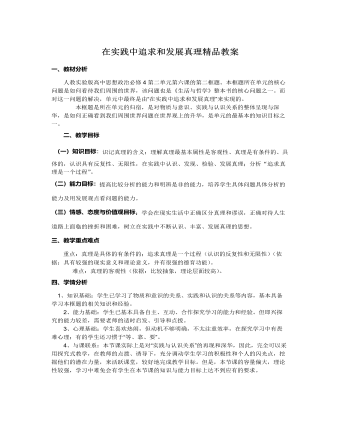
人教版高中政治必修4在实践中追求和发展真理精品教案
一、教材分析人教实验版高中思想政治必修4第二单元第六课的第二框题。本框题所在单元的核心问题是如何看待我们周围的世界,该问题也是《生活与哲学》整本书的核心问题之一。而对这一问题的解决,单元中最终是由“在实践中追求和发展真理”来实现的。 本框题是所在单元的归宿,是对物质与意识、实践与认识关系的整体呈现与深华,是如何正确看到我们周围世界问题在世界观上的升华,是单元的最基本的知识目标之一。 二、教学目标(一)知识目标:识记真理的含义;理解真理最基本属性是客观性、真理是有条件的、具体的,认识具有反复性、无限性,在实践中认识、发现、检验、发展真理;分析“追求 真理是一个过程”。(二)能力目标:提高比较分析的能力和明辨是非的能力,培养学生具体问题具体分析的能力及用发展观点看问题的能力。(三)情感、态度与价值观目标:学会在现实生活中正确区分真理和谬误,正确对待人生道路上面临的挫折和困难,树立在实践中不断认识、丰富、发展真理的思想。
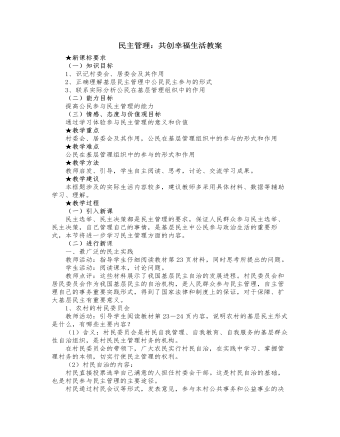
人教版高中政治必修2民主管理:共创幸福生活教案
教师活动:请同学们阅读教材P26页图表,思考所提的问题。学生活动:阅读课本,积极思考。教师点评:公民应在本地事务中增强主人翁责任感,积极参与民主管理。在参与民主管理的过程中,学习民主管理的知识和技能,体验民主管理的意义和价值,逐步增强和提高自己政治参与的责任意识和实际本领。2、青年学生应积极参与民主管理青年学生应着眼于未来发展,积极参与民主管理。在基层民主自治这种最广泛的民主实践中,获得更多民主管理机会,以不同方式尝试参与参与民主管理活动。在参与民主管理的过程中,学习民主管理的知识和技能,体验民主管理的意义和价值,逐步增强和提高自己政治参与的责任意识和实际本领。(三)课堂总结、点评本节内容讲述了我国的基层民主管理形式和主要内容,明确了积极参与基层民主管理的重要意义,这对我们提高自身政治素质,增强参与政治生活的责任感和能力等,有重大作用。
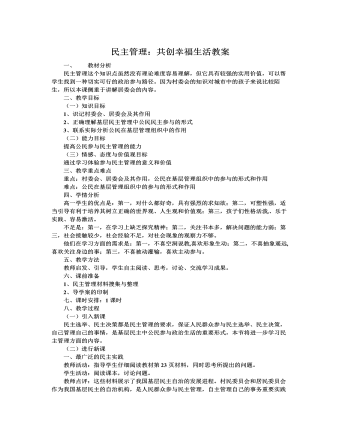
人教版高中政治必修2民主管理:共创幸福生活教案
一、 教材分析民主管理这个知识点虽然没有理论难度容易理解,但它具有较强的实用价值,可以帮学生找到一种切实可行的政治参与路径。因为村委会的知识对城市中的孩子来说比较陌生,所以本课侧重于讲解居委会的内容。二、教学目标(一)知识目标1、识记村委会、居委会及其作用2、正确理解基层民主管理中公民民主参与的形式3、联系实际分析公民在基层管理组织中的作用(二)能力目标提高公民参与民主管理的能力(三)情感、态度与价值观目标通过学习体验参与民主管理的意义和价值三、教学重点难点重点:村委会、居委会及其作用,公民在基层管理组织中的参与的形式和作用难点:公民在基层管理组织中的参与的形式和作用四、学情分析高一学生的优点是:第一,对什么都好奇,具有强烈的求知欲;第二,可塑性强,适当引导有利于培养其树立正确的世界观、人生观和价值观;第三,孩子们性格活泼,、乐于实践、容易激活。
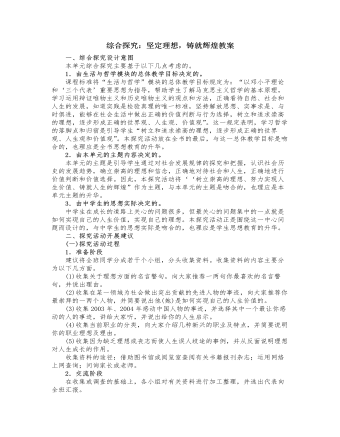
人教版高中政治必修4综合探究:坚定理想,铸就辉煌教案
理想扎根在实践的土壤中理想当然是重要的,但是不能把理想当成幻想或空想,理想必须扎根在实践的土壤中。青年人充满激情,这是非常重要的。古人有句话:“哀莫大于心死”。最大的悲哀就是没有追求,就像一团火焰熄灭了一样,即使到了我这个年纪也不能“哀莫大于心死”。青年人都有很高的激情,这是很好的。但是青年的激情往往不大稳定,过去人们说青年人的热情是“三分钟的热度”。这句话不一定准确,但青年人在这一点上应该有一个正确的认识。记得我大学毕业时,对于走向社会、走向生活充满了幻想,认为生活中的一切都是美好的,是典型的理想主义者,因此,对自己不能正确的估价,好高骛远,只愿做大事,不愿也不注意从小事积累。列宁说过,大事是由小事积累而成的。我当初毕业时,一方面充满了激情,另一方面也确实过高地估计了自己。
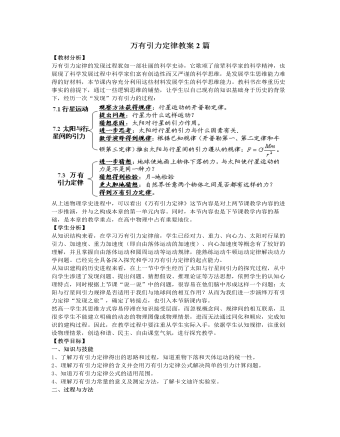
人教版新课标高中物理必修2万有引力定律教案2篇
3.适用条件(1)万有引力定律只适用于质点间引力大小的计算。当两物体间的距离远远大于每个物体的尺寸时,物体可以看成质点,直接使用万有引力定律计算。(模型)研究相互接触的两个人之间的万有引力时,不能把他们看作质点。(2)当两物体是质量均匀分布的球体时,它们间的引力也可直接用公式计算,但式中的r是指两球心间距离。研究太阳和地球之间的万有引力,可以把它们看作质量均匀的球体。当研究物体不能看成质点时,可以把物体假想分割成无数个质点,求出两个物体上每个质点与另一物体上所有质点的万有引力,然后求合力,这是微积分的思想。万有引力定律产生于对太阳系行星运动的研究,但它对物质运动的适用性却要广泛得多。可以这样说,宇宙中凡有引力参与的一切复杂的现象,无不要归结到这样一条十分简洁的定律之中,这不能不使人惊叹宇宙万物超乎寻常的和谐及人类理性思考所具有的统摄力。
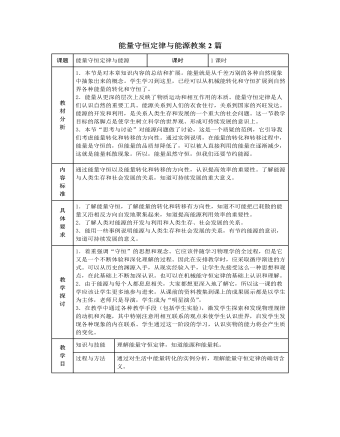
人教版新课标高中物理必修2能量守恒定律与能源教案2篇
世界能源问题的解决途径是什么?能源,是人类敕以生存和进行生产的不可缺少的资源.近年来,随着生产力的发展和能源消费的增长.能源问题已被列为世界上研究的重大问题之一.解决世界能源问题的根本途径,主要有两个方面:其一是广泛开源,其二是认真节流.所谓开源,就是积极开发和利用各种能源.在继续加紧石油勘探和寻找新的石油产地的同时,积极开发丰富的煤炭资源,还要大力开发水能,生物能等常规能源,加强核能、太阳能,风能、沼气,海洋能,地热能以及其他各种新能源的研究和利用,从而不断扩大人类的能源资源的种类和来源.所谓节流,就是要大力提倡节约能源.节能是世界上许多国家关心和研究的重要课题,甚至有人把节能称为世界的“第五大能源”,与煤、石油和天然气、水能、核能等并列.在节能方面,在有计划地控制人口增长的同时,重点要发挥先进科学技术的优势,提高各国的能源利用效率.
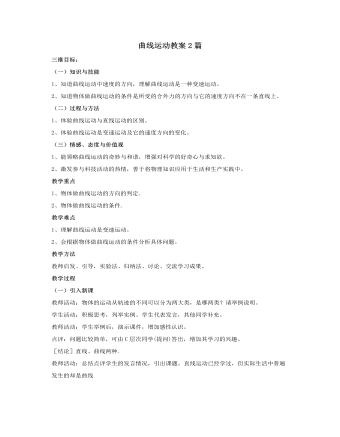
人教版新课标高中物理必修2曲线运动教案2篇
1、教师先演示投影:把小钢珠放在黑墨水瓶盖里转一下(内有一点点墨水),再放在半圆形有机玻璃轨道上运动并飞出,让钢珠在白纸上留下痕迹,同样在3/5半圆周,4/5半圆周上运动飞出,让学生猜测飞出方向由什么特点?(有机玻璃板说明:厚约5毫米,略小于小钢珠直径,圆弧半径15厘米,MN边稍长些,以便过MN做直线,根据半径大小确定圆心O位置。)学生猜想:切线方向师:已知圆弧半径为15厘米。如何验证?请用几何方法作图验证。生:标出飞出点和圆心,做圆心和飞出点的连线,用量角尺量出该连线和飞出轨迹直线的夹角,是否90度。2、再分组实验,提醒同桌配合,小心钢珠滚跑。实验完毕,要求作图验证,并互相讨论交流。3、交流和结论:师:要引导学生得出正确的科学结论:“圆周运动的物体的速度方向为该点的切线方向”,而不能直接得出“曲线运动的的物体速度方向为该点的切线方向”。
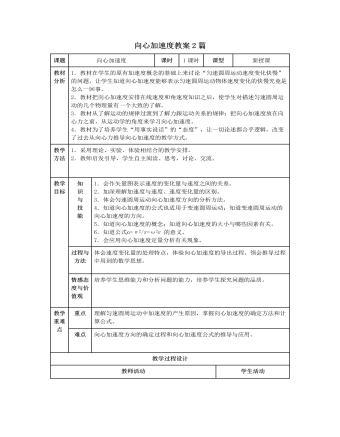
人教版新课标高中物理必修2向心加速度教案2篇
1.教材在学生的原有加速度概念的基础上来讨论“匀速圆周运动速度变化快慢”的问题,让学生知道向心加速度能够表示匀速圆周运动物体速度变化的快慢究竟是怎么一回事。2.教材把向心加速度安排在线速度和角速度知识之后,使学生对描述匀速圆周运动的几个物理量有一个大致的了解。3.教材从了解运动的规律过渡到了解力跟运动关系的规律;把向心加速度放在向心力之前,从运动学的角度来学习向心加速度。4.教材为了培养学生“用事实说话”的“态度”,让一切论述都合乎逻辑,改变了过去从向心力推导向心加速度的教学方式。1.采用理论、实验、体验相结合的教学安排。2.教师启发引导,学生自主阅读、思考,讨论、交流。知识与技能1.会作矢量图表示速度的变化量与速度之间的关系。2.加深理解加速度与速度、速度变化量的区别。3.体会匀速圆周运动向心加速度方向的分析方法。4.知道向心加速度的公式也适用于变速圆周运动;知道变速圆周运动的向心加速度的方向。
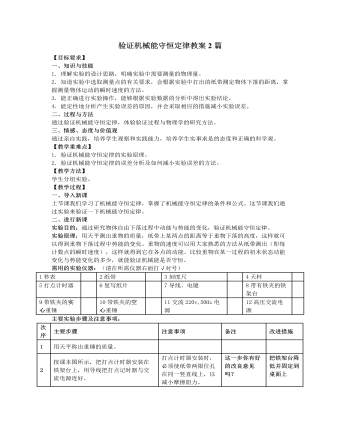
人教版新课标高中物理必修2验证机械能守恒定律教案2篇
教学目标㈠知识与技能1.要弄清实验目的,本实验为验证性实验,目的是利用重物的自由下落验证机械能守恒定律。2.要明确实验原理,掌握实验的操作方法与技巧、学会实验数据的采集与处理,能够进行实验误差的分析,从而使我们对机械能守恒定律的认识,不止停留在理论的推导上,而且还能够通过亲自操作和实际观测,从感性上增加认识,深化对机械能守恒定律的理解。3.要明确织带选取及测量瞬时速度简单而准确的方法。㈡过程与方法1.通过学生自主学习,培养学生设计实验、采集数据,处理数据及实验误差分析的能力。2.通过同学们的亲自操作和实际观测掌握实验的方法与技巧。3.通过对纸带的处理过程培养学生获取信息、处理信息的能力,体会处理问题的方法,领悟如何间接测一些不能直接测量的物理量的方法。
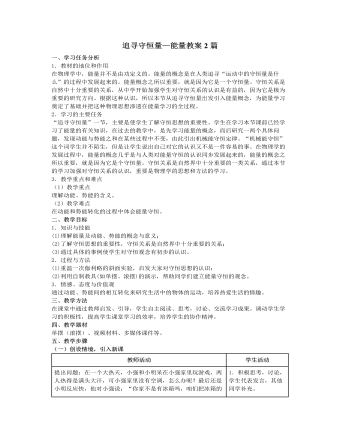
人教版新课标高中物理必修2追寻守恒量—能量教案2篇
一、学习任务分析1.教材的地位和作用在物理学中,能量并不是由功定义的。能量的概念是在人类追寻“运动中的守恒量是什么”的过程中发展起来的。能量概念之所以重要,就是因为它是一个守恒量。守恒关系是自然中十分重要的关系,从中学开始加强学生对守恒关系的认识是有益的,因为它是极为重要的研究方向。根据这种认识,所以本节从追寻守恒量出发引入能量概念,为能量学习奠定了基础并把这种物理思想渗透在能量学习的全过程。2.学习的主要任务“追寻守恒量”一节,主要是使学生了解守恒思想的重要性。学生在学习本节课前已经学习了能量的有关知识,在过去的教学中,是先学习能量的概念,而后研究一两个具体问题,发现动能与势能之和在某些过程中不变,由此引出机械能守恒定律。“机械能守恒”这个词学生并不陌生,但是让学生说出自己对它的认识又不是一件容易的事。





















